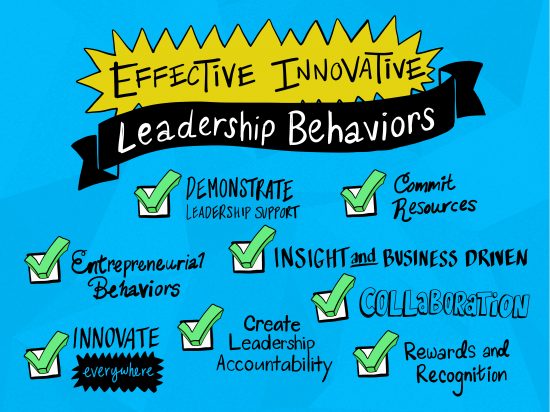In this blog series, I’ve explored the key role leaders must play to successfully build and nurture an innovative culture throughout an organisation. For many leaders, particularly those running large, well established businesses, it can be a daunting prospect. In an environment where tangible results are everything, the ambiguous and uncertain nature of innovation can feel like a distraction, forcing it into the back seat. And this failure to plan for tomorrow means there won’t be a tomorrow. Innovation isn’t just for startups. Even small investments today can reap significant dividends down the line.
An effective leader doesn’t need to be the expert in every department. Innovation is a collective, team effort and knowing personal limitations is a critical part of team building. Individuals can be recruited to fill any weaknesses, ensuring strong knowledge and skills in every position. Your primary role as a leader is that of the conductor, leading from the front, setting the tempo (and example), ensuring all team members work together towards common goals.
Effective leadership of innovation also requires essential behaviours that encourage a lasting, innovation-focussed mindset—from the postroom to the boardroom. In this series, I highlighted eight required behaviours to accomplish this:
- Demonstrate leadership support: “Walk the walk,” clearly communicate organisational innovation goals and provide appropriate training
- Commit resources: Ring fence budgets for innovation and ensure employees have the time to focus on innovation objectives
- Create leadership accountability: Report on innovation progress at the board level, build diverse portfolios of innovation projects and assign responsibilities to senior team members
- Insight and business driven: Talk with customers to understand their problems, give innovation teams access to necessary data and insights, validate new ideas regularly
- Collaboration: Assemble innovation teams based on unique skills or perspectives they bring to the table, encourage cross-organisational collaboration wherever possible
- Rewards and recognition: Ensure both successful outcomes and innovative behaviour are recognised and rewarded regularly, encouraging employees to think boldly in everything they do
- Innovate everywhere: Instill a “passionately dissatisfied” mentality amongst employees, create working environments that encourage the free exchange of ideas and risk taking with new innovation concepts
- Entrepreneurial behaviour: Encourage an entrepreneurial spirit throughout the organisation, leading from the front without fear of failure

Remember that innovation begins and ends with effective leadership. It must be a leadership-led activity. Rather than viewing it as a distraction, you must see it as a strategic investment to secure the future. But this doesn’t mean innovation is a leader’s sole responsibility—it’s a team effort.
Exhibiting the essential behaviours above will instill an innovative mindset throughout even the most stubborn and change-resistant organisation, creating a culture of bold thinking, constant learning, collaboration, celebration, and most importantly, innovation.
Voip.sip install.com
Voip.sip install.com